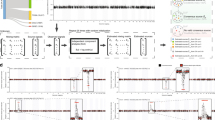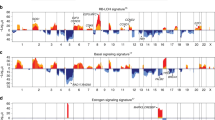Abstract
Gene expression signatures encompassing dozens to hundreds of genes have been associated with many important parameters of cancer, but mechanisms of their control are largely unknown. Here we present a method based on genetic linkage that can prospectively identify functional regulators driving large-scale transcriptional signatures in cancer. Using this method we show that the wound response signature, a poor-prognosis expression pattern of 512 genes in breast cancer, is induced by coordinate amplifications of MYC and CSN5 (also known as JAB1 or COPS5). This information enabled experimental recapitulation, functional assessment and mechanistic elucidation of the wound signature in breast epithelial cells.
This is a preview of subscription content, access via your institution
Access options
Subscribe to this journal
Receive 12 print issues and online access
$209.00 per year
only $17.42 per issue
Buy this article
- Purchase on Springer Link
- Instant access to full article PDF
Prices may be subject to local taxes which are calculated during checkout







Similar content being viewed by others
Accession codes
References
Liu, E.T. Classification of cancers by expression profiling. Curr. Opin. Genet. Dev. 13, 97–103 (2003).
Perou, C.M. et al. Molecular portraits of human breast tumours. Nature 406, 747–752 (2000).
Sorlie, T. et al. Gene expression patterns of breast carcinomas distinguish tumor subclasses with clinical implications. Proc. Natl. Acad. Sci. USA 98, 10869–10874 (2001).
van 't Veer, L.J. et al. Gene expression profiling predicts clinical outcome of breast cancer. Nature 415, 530–536 (2002).
Chang, H.Y. et al. Gene expression signature of fibroblast serum response predicts human cancer progression: Similarities between tumors and wounds. PLoS Biol. 2, 206–214 (2004).
Pollack, J.R. et al. Microarray analysis reveals a major direct role of DNA copy number alteration in the transcriptional program of human breast tumors. Proc. Natl. Acad. Sci. USA 99, 12963–12968 (2002).
Huang, E. et al. Gene expression phenotypic models that predict the activity of oncogenic pathways. Nat. Genet. 34, 226–230 (2003).
Sweet-Cordero, A. et al. An oncogenic KRAS2 expression signature identified by cross-species gene-expression analysis. Nat. Genet. 37, 48–55 (2005).
Dvorak, H.F. Tumors: wounds that do not heal. Similarities between tumor stroma generation and wound healing. N. Engl. J. Med. 315, 1650–1659 (1986).
Bissell, M.J. & Radisky, D. Putting tumours in context. Nat. Rev. Cancer 1, 46–54 (2001).
Cooper, L., Johnson, C., Burslem, F. & Martin, P. Wound healing and inflammation genes revealed by array analysis of 'macrophageless' PU.1 null mice. Genome Biol. 6, R5 (2005).
Chang, H.Y. et al. Robustness, scalability, and integration of a wound response gene expression signature in predicting survival of human breast cancer patients. Proc. Natl. Acad. Sci. USA 102, 3738–3743 (2005).
Mootha, V.K. et al. PGC-1alpha-responsive genes involved in oxidative phosphorylation are coordinately downregulated in human diabetes. Nat. Genet. 34, 267–273 (2003).
Segal, E., Friedman, N., Koller, D. & Regev, A. A module map showing conditional activity of expression modules in cancer. Nat. Genet. 36, 1090–1098 (2004).
Tusher, V.G., Tibshirani, R. & Chu, G. Significance analysis of microarrays applied to the ionizing radiation response. Proc. Natl. Acad. Sci. USA 98, 5116–5121 (2001).
Cope, G.A. & Deshaies, R.J. COP9 signalosome: a multifunctional regulator of SCF and other cullin-based ubiquitin ligases. Cell 114, 663–671 (2003).
Ginzinger, D.G. et al. Measurement of DNA copy number at microsatellite loci using quantitative PCR analysis. Cancer Res. 60, 5405–5409 (2000).
Iyer, V.R. et al. The transcriptional program in the response of human fibroblasts to serum. Science 283, 83–87 (1999).
Kelly, K., Cochran, B.H., Stiles, C.D. & Leder, P. Cell-specific regulation of the c-myc gene by lymphocyte mitogens and platelet-derived growth factor. Cell 35, 603–610 (1983).
Frank, S.R., Schroeder, M., Fernandez, P., Taubert, S. & Amati, B. Binding of c-Myc to chromatin mediates mitogen-induced acetylation of histone H4 and gene activation. Genes Dev. 15, 2069–2082 (2001).
Felsher, D.W., Zetterberg, A., Zhu, J., Tlsty, T. & Bishop, J.M. Overexpression of MYC causes p53-dependent G2 arrest of normal fibroblasts. Proc. Natl. Acad. Sci. USA 97, 10544–10548 (2000).
Tomoda, K., Kubota, Y. & Kato, J. Degradation of the cyclin-dependent-kinase inhibitor p27Kip1 is instigated by Jab1. Nature 398, 160–165 (1999).
Fernandez, P.C. et al. Genomic targets of the human c-Myc protein. Genes Dev. 17, 1115–1129 (2003).
Soule, H.D. et al. Isolation and characterization of a spontaneously immortalized human breast epithelial cell line, MCF-10. Cancer Res. 50, 6075–6086 (1990).
Pear, W.S., Nolan, G.P., Scott, M.L. & Baltimore, D. Production of high-titer helper-free retroviruses by transient transfection. Proc. Natl. Acad. Sci. USA 90, 8392–8396 (1993).
Ashburner, M. et al. Gene ontology: tool for the unification of biology. The Gene Ontology Consortium. Nat. Genet. 25, 25–29 (2000).
Schmidt, E.V. The role of c-myc in cellular growth control. Oncogene 18, 2988–2996 (1999).
Lamb, J. et al. A mechanism of cyclin d1 action encoded in the patterns of gene expression in human cancer. Cell 114, 323–334 (2003).
Amati, B. Myc degradation: dancing with ubiquitin ligases. Proc. Natl. Acad. Sci. USA 101, 8843–8844 (2004).
Sears, R. et al. Multiple Ras-dependent phosphorylation pathways regulate Myc protein stability. Genes Dev. 14, 2501–2514 (2000).
Welcker, M. et al. The Fbw7 tumor suppressor regulates glycogen synthase kinase 3 phosphorylation-dependent c-Myc protein degradation. Proc. Natl. Acad. Sci. USA 101, 9085–9090 (2004).
Yada, M. et al. Phosphorylation-dependent degradation of c-Myc is mediated by the F-box protein Fbw7. EMBO J. 23, 2116–2125 (2004).
Kim, S.Y., Herbst, A., Tworkowski, K.A., Salghetti, S.E. & Tansey, W.P. Skp2 regulates Myc protein stability and activity. Mol. Cell 11, 1177–1188 (2003).
von der Lehr, N. et al. The F-box protein Skp2 participates in c-Myc proteosomal degradation and acts as a cofactor for c-Myc-regulated transcription. Mol. Cell 11, 1189–1200 (2003).
Wee, S., Geyer, R.K., Toda, T. & Wolf, D.A. CSN facilitates Cullin-RING ubiquitin ligase function by counteracting autocatalytic adapter instability. Nat. Cell Biol. 7, 387–391 (2005).
Alt, J.R., Greiner, T.C., Cleveland, J.L. & Eischen, C.M. Mdm2 haplo-insufficiency profoundly inhibits Myc-induced lymphomagenesis. EMBO J. 22, 1442–1450 (2003).
Slack, A. et al. The p53 regulatory gene MDM2 is a direct transcriptional target of MYCN in neuroblastoma. Proc. Natl. Acad. Sci. USA 102, 731–736 (2005).
Diehn, M. et al. SOURCE: a unified genomic resource of functional annotations, ontologies, and gene expression data. Nucleic Acids Res. 31, 219–223 (2003).
Wang, Z.C. et al. Loss of heterozygosity and its correlation with expression profiles in subclasses of invasive breast cancers. Cancer Res. 64, 64–71 (2004).
Aguirre, A.J. et al. High-resolution characterization of the pancreatic adenocarcinoma genome. Proc. Natl. Acad. Sci. USA 101, 9067–9072 (2004).
Weber, M. et al. Chromosome-wide and promoter-specific analyses identify sites of differential DNA methylation in normal and transformed human cells. Nat. Genet. 37, 853–862 (2005).
Elenbaas, B. et al. Human breast cancer cells generated by oncogenic transformation of primary mammary epithelial cells. Genes Dev. 15, 50–65 (2001).
Zhao, J.J. et al. Human mammary epithelial cell transformation through the activation of phosphatidylinositol 3-kinase. Cancer Cell 3, 483–495 (2003).
Bemis, L. et al. Distinct aerobic and hypoxic mechanisms of HIF-alpha regulation by CSN5. Genes Dev. 18, 739–744 (2004).
Chi, J.T. et al. Genomewide view of gene silencing by small interfering RNAs. Proc. Natl. Acad. Sci. USA 100, 6343–6346 (2003).
Kim, B.C. et al. Jab1/CSN5, a component of the COP9 signalosome, regulates transforming growth factor beta signaling by binding to Smad7 and promoting its degradation. Mol. Cell. Biol. 24, 2251–2262 (2004).
Chang, H.Y. et al. Diversity, topographic differentiation, and positional memory in human fibroblasts. Proc. Natl. Acad. Sci. USA 99, 12877–12882 (2002).
Acknowledgements
We thank E. Huntziker, A.E. Oro, W. Tansey, L. Bemis, X. Chen and D.W. Felsher for reagents, T.W. Ridky and P.A. Khavari for assistance with animal experiments, Y. Liu for technical assistance, members of the Program in Epithelial Biology for discussion and D.W. Felsher, P.A. Khavari, A.E. Oro, E. Segal and J.L. Rinn for comments on the manuscript. This work was supported by grants from the US National Institutes of Health (AR050007, CA09302) and the Dutch Cancer Society (NKB 2002-2575). H.Y.C. is a Damon Runyon Scholar supported by the Damon Runyon Cancer Research Foundation.
Author information
Authors and Affiliations
Corresponding author
Ethics declarations
Competing interests
A.S.A., M.L. and H.Y.C. are named as inventors on a patent application describing the SLAMS method.
Supplementary information
Supplementary Fig. 1
DNA copy number and expession patterns of MYC and CSN5. (PDF 66 kb)
Supplementary Fig. 2
Nonlinear relationship between wound signature score and probability of gene coregulation. (PDF 75 kb)
Supplementary Table 1
DNA amplification associated with wound signature expression. (PDF 259 kb)
Supplementary Table 2
List of published prognostic signatures in human breast cancer used in the gene module map analysis. (PDF 217 kb)
Supplementary Table 3
MYC target genes that are coactivated by CSN5 expression. (PDF 240 kb)
Supplementary Table 4
Primer sequences for quantitative microsatellite analysis (QuMA). (PDF 154 kb)
Rights and permissions
About this article
Cite this article
Adler, A., Lin, M., Horlings, H. et al. Genetic regulators of large-scale transcriptional signatures in cancer. Nat Genet 38, 421–430 (2006). https://doi.org/10.1038/ng1752
Received:
Accepted:
Published:
Issue Date:
DOI: https://doi.org/10.1038/ng1752
This article is cited by
-
Regulatory mechanisms and therapeutic potential of JAB1 in neurological development and disorders
Molecular Medicine (2023)
-
Prognostic value of CSN5 in patients with digestive system cancers: a systematic review and meta-analysis
BMC Cancer (2022)
-
Prognostic and therapeutic significance of COP9 signalosome subunit CSN5 in prostate cancer
Oncogene (2022)
-
Jab1/Cops5: a promising target for cancer diagnosis and therapy
International Journal of Clinical Oncology (2021)
-
Amplification and overexpression of PSCA at 8q24 in invasive micropapillary carcinoma of breast
Breast Cancer Research and Treatment (2017)



